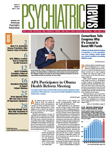Various forms of violence by patients against psychiatry residents—from inappropriate touching and verbal abuse to outright physical assault—are not rare in training programs.
Moreover, such incidents can be traumatizing, causing some young psychiatrists to consider leaving the specialty.
Those were tentative conclusions of a nationwide survey of psychiatry residents regarding incidents of violence in the workplace presented at last month's meeting of the American Association of Directors of Psychiatric Residency Training (AADPRT) in Tucson, Ariz.
Marshall Forstein, M.D., who conducted the survey, said the results point to a problem that may be “flying under the radar” of program directors. Of particular concern is a finding showing that many residents do not report incidents to program directors or to security, and the fact that some respondents said they had been so severely affected by a violent incident that it caused them to reconsider their choice of specialty.
Forstein is director of adult psychiatry residency training at Cambridge Hospital in Cambridge, Mass, and is an APA-nominated member of the Residency Review Committee for Psychiatry of the Accreditation Council for Graduate Medical Education.
Forstein cautioned that the response rate to the survey (approximately 13 percent) was low, and not all respondents answered all questions. Still, the results are worthy of attention, he said.
“The amount of violence reported in the survey across the spectrum of severity is significant and really indicates a problem we as program directors need to think about,” Forstein told Psychiatric News.“ The rate of reporting [of violent incidents by residents to authorities] is less than I would have expected and suggests we need to be thinking about how to get the message across to residents that we want to know everything.”
The survey results were presented at the AADPRT meeting in the session“ The Psychiatric Resident Experience of Violence in the Workplace: Training Issues and Clinical Supervision.” Training directors and faculty at the session, many of whom came with their own vignettes of workplace violence, agreed that the problem is significant and said it points to a number of challenges for psychiatric education: how to create systems to prevent violent incidents or to rapidly de-escalate them when they do happen; and how to create an atmosphere in which residents can feel supported and nurtured in the aftermath of a violent incident.
Some participants—echoing resident comments reflected in the survey—said that while many violent episodes occur in the context of treating patients having a psychotic episode, the problem is also compounded by the increasing numbers of antisocial and/or drug-abusing individuals who may be sent to psychiatric inpatient centers.
The survey was sent to all psychiatry residency training programs in the United States. Of some 4,700 residents and fellows at programs to which the surveys were mailed, 570 responded: 349 women and 221 men.
Residents were asked to report the occurrence of the following incidents: harassing phone calls, threatening phone calls, face-to-face verbal assaults, threatening e-mails or letters, physical assaults, directed sexual comments, inappropriate touching, and sexual assaults. (Respondents could indicate more than one incident.)
The response rate was roughly equivalent across the four years of residency, ranging from 22 percent to 23.4 percent for all four residency years. Response rates from fellows in PGY-5, -6, and -7 were smaller, all under 10 percent.
Respondents covered all geographic regions of the country and all major training settings.
The tally came to 327 face-to-face verbal assaults, 187 directed sexual comments, 113 incidents of physical assault, 106 harassing phone calls, and three sexual assaults. There were only a few threatening phone calls, e-mails or letters, and incidents of inappropriate touching.
The survey also asked respondents to indicate in which of the following settings the incident had occurred: psychiatric emergency department, medical emergency department, psychiatric inpatient ward, medical inpatient ward, partial hospitalization program, community outreach program (such as PACT team setting), or outpatient setting.
The three reported sexual assaults occurred in three settings: a psychiatric emergency department, medical emergency department, and psychiatric inpatient unit.
The highest percentage of physical assaults (63.7 percent) occurred in the psychiatric inpatient unit, while the highest percentage of face-to-face verbal assaults occurred in the psychiatric emergency department.
Threatening phone calls, e-mails, or letters were most common in outpatient settings. Community outreach settings recorded the smallest number of incidents, with one harassing phone call and incident of inappropriate touching recorded.
Residents were also queried about whether and to whom they reported an incident and the response by the program or institution to the incident. Of 357 residents who responded to this question, most said they reported an incident to their immediate attending physician (68.1 percent), to another resident (51.0 percent), and/or to other staff at the site (50.7 percent).
Only 14.9 percent of the 357 respondents reported an incident to the program director, and only 33.9 percent reported the incident to security.
When asked how supported they felt by their program or institution, 208 residents said they felt “very supported,” while 123 felt“ somewhat supported,” and 37 felt “not very supported.”
Finally, among residents responding to a question about whether a violent incident had caused them to consider leaving psychiatry, 18 residents responded “yes.”
“That worries me,” Forstein told participants at the AADPRT meeting. “I don't want to think we are possibly losing even one promising psychiatrist because of events like this.”
He emphasized that the survey has a number of limitations and that the results point to any number of unanswered questions.
The survey appears to be the first of its kind: an initial literature search revealed that past research on psychiatric workplace violence is scarce and is largely confined to the experience of nursing and milieu staff.
“What we know is that the literature is scarce, violence is underreported, and this is not a small problem,” Forstein said.▪
